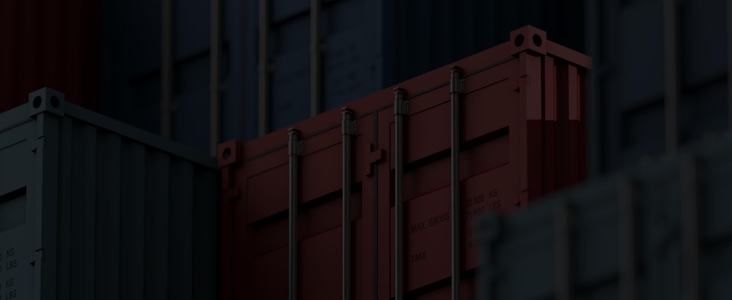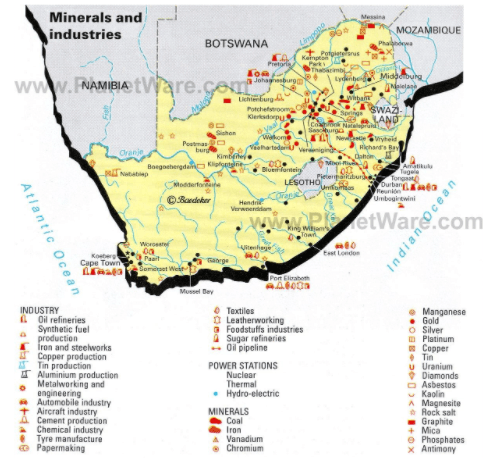
An export guide to transporting cargo from South Africa
Get information and quote for FCL and LCL shipping
South Africa located on the southern tip of Africa, boasts a growing population and economy. The country has a population of approximately 58 million and a total GDP of about $301 billion, making it an emerging player in the global economy.
This guide will go through some important aspects of shipping from South Africa, such as customs processes, documentation, and tax regulations.
What are Your Options for Shipping Freight From South Africa?
Freight shipping from South Africa can be conducted via ocean freight or air freight.
Ocean Freight From South Africa
Shipping cargo from South Africa by sea gives you two options, either less than container load (LCL) or full container load (FCL). In less than container load, your goods will be consolidated with consignments from other sellers, which will then be shipped together in one container. LCL is best for small cargo and those that are not perishable or delicate.
In case you are shipping large or heavy cargo, you may need to choose full container load shipping instead. In FCL, your goods will be shipped in isolation, which means that you have the space in an entire container all to yourself. While this is a preferred mode of shipment for delicate and perishable items, it can cost more than LCL.
Air Freight From South Africa
You can also ship freight from South Africa by air. While this is a more expensive shipping option, it is very quick and flexible, thus allowing you to get your cargo to your destination country more seamlessly. However, air freight may have certain limitations when it comes to the size, volume, and type of cargo that you can ship.
How Much Does it Cost to Ship Cargo From South Africa?
The cost of shipping cargo from South Africa is dependent on a variety of factors, such as:
- The type of goods you are shipping
- Your chosen mode of shipment (ocean freight or air freight)
- The weight and volume of your cargo
- The size/ dimensions of your cargo
- The distance between South Africa and your destination country
- Specific movement types, i.e. door-to-door, port-to-door, door-to-port, port-to-port
You can request a more accurate quote of your shipping costs from your freight forwarder.
How Long Does it Take to Ship Cargo From South Africa?
The transit time for your cargo will depend on the chosen mode of shipment you select, whether the route of your ship or airplane is direct or has multiple stops, and the distance between Africa and your destination port or airport.
Here are some estimated transit times:
Air Freight From South Africa
Destination Country|Transit Time| ---------------- | ---------------- |----------: Malaysia|10 days Australia|10 days China|10 days United States|10 days
Exporting from South Africa
To export certain goods out of South Africa, you must have a permit ensuring that you comply with applicable export control measures. The export of some goods may be restricted to assist local manufacturers to obtain raw materials before they are exported.
An export permit is required to ensure that goods exported by an individual or organization comply with the provisions of international agreements. Export permits also help to control the outflow of goods, including smuggled and stolen goods.
The policy that applies to the export of goods differs from sector to sector. If you require policy information regarding the export of specific goods, you should provide the Import and Export Control office at the International Trade Administration Commission (ITAC) with details of the particular goods you want to export.
Not all goods or products are subject to export control measures. A list of goods that are subject to export control measures is available from ITAC. This list may also be mailed, faxed, or e-mailed to you on request.
Steps to Follow for Export Permit
- Download and complete the applicable application form.
- Submit the forms to the Directorate: Import and Export Control.
Expected Time of Processing
The turnaround time for processing an application is two working days on average, with an exception of export permits for scrap metals, which take 10 working days for circulation, plus time for processing and issuing. This service is free.
Forms to complete
Form IE230: Application to register as an Exporter or Change of current information(link is external) Form IE361: Export Permit General goods(link is external) Form IE362: Export Permit for Motor Vehicles(link is external) Form IE363: Export permit Waste and Scrap metal(link is external)
Shipping From South Africa: FCL or LCL?
If you have chosen to ship your cargo from South Africa by sea, you will need to decide if you will go with a full container load or less than container load shipment. The right choice would depend on your priorities, as well as the nature and particulars of your cargo.
Less than Container Load from South Africa
Less than container load shipping may be a viable option for you if your cargo is:
- Small in size and quantity
- Suitable for consolidation with cargo from other sellers
- Not expected in your destination country at a specified time
- Suitable for frequent handling and movement
- Not perishable, fragile, or delicate
Full Container Load from South Africa
On the other hand, if the following is true about your cargo, full container load may be a better option:
- It is large, bulky, and oversized
- It is better of shipped in isolation
- It is expected in your destination country at a specified time
- It is not suitable for frequent handling and movement
- It is perishable, fragile, or delicate
Top Cargo Ports in South Africa
South Africa has six major commercial ports: Durban, Richards Bay, Cape Town, Saldanha Bay, Port Elizabeth, and East London.
Durban
Durban has five deep-sea and two coastal container berths and provides 15,195 meters of quayage for commercial ships. Durban also has repair facilities, including a floating dry dock, in a port that encompasses 893 hectares of the bay area.
Richards Bay
Richards Bay, a deep-water port 193 kilometers northeast of Durban, can accommodate bulk carriers of up to 250,000 tons, with five berths for general and bulk cargo, and a coal berth.
Cape Town
Cape Town includes five berths for container vessels and general cargo carriers, a pier for coastal traffic, and extensive ship repair facilities. The port at Cape Town has a water area of 112.7 hectares.
Port Elizabeth
Port Elizabeth's enclosed water area of about 115 hectares has more than 3,400 meters of quayage for commercial shipping and a container terminal that has two berths. Facilities at Port Elizabeth include a mechanical ore-handling plant, which can process up to 1,500 tons per hour, and a precooling storage area with a capacity of 7,500 cubic meters.
Saldanha Bay
Saldanha Bay’s port provides anchorage in the protection of a breakwater where the minimum water depth is 14.6 meters. With a port area of about 5,000 hectares, Saldanha Bay is larger than the combined areas of the ports of Durban, Cape Town, Port Elizabeth, and East London. The ore-loading jetty can handle carriers of 350,000 tons.
East London
East London, South Africa's only river port, is situated at the estuary of the Buffalo River in Eastern Cape Province. East London is the smallest of the six major ports, but it has a 75,000-ton capacity grain elevator, which is the largest in South Africa.
Top Airports in South Africa
The top airports for traffic are as follows:
IATA|Name|City|Airlines|Destinations| ------- | ---------------- | ---------------- | ---------------- | ---------------- |----------: JNB|OR Tambo International Airport|Johannesburg|49|81 CPT|Cape Town International Airport|Cape Town|19|23 DUR|King Shaka International Airport|Durban|6|13 GRJ|George Airport|George|3|3 HLA|Lanseria Airport|Johannesburg|3|2 PLZ|Port Elizabeth Airport|Port Elizabeth|3|4 BFN|Bram Fischer International Airport|Bloemfontein|2|3
Source: South Africa World Data
Top Commodities Exported from South Africa (2019)
- Gold - 15.5%
- Platinum - 8.86%
- Cars - 7.01%
- Iron Ore - 6.19%
- Coal Briquettes - 4.65%
Top Tradelanes from South Africa
- China - 15.4%
- United Kingdom - 7.83%
- Germany - 7.46%
- United States - 6.29%
- India - 5.55%
Manufacturing Map of South Africa

Source: South Africa Minerals and Industries Map
E-commerce in South Africa
Clothing and apparel are the top two e-Commerce products in South Africa followed by media products. There is also growth in most food delivery platforms both grocery and fast food/convenience. UberEATS is available in South Africa and competes with the local platform called Mr. Delivery. Consumers are price-sensitive, favoring online promotions and coupons.
Cross-Border E-Commerce
South Africans purchase mostly from South African websites or online marketplaces, but 27% purchase from the United States, and 14% from Europe. The U.S. version of Amazon.com is the third most visited e-commerce website in South Africa. If a South African imports goods in excess of ZAR10 000 ($580) or more than three times a year they will have to get an importers code, irrespective if it is for personal or business use.
Online Payment
Credit cards and debit cards are the most preferred payment methods. Consumers also use e-wallet services and EFT for online payment. Due to the growth of credit card fraud, the Payment Association of South Africa mandated the use of 3D Secure in 2014.
Merchants have reported that increased flexibility in the application of 3D Secure to online transactions in recent years has reduced cart abandonment by consumers. Currently, around 71% of potential customers abandon their carts because of payment gateway failure.
Mobile E-Commerce
Cell phones have largely replaced wallets, as banks, card operators, retailers and communications companies provide alternatives to cash as a means of payment. M-commerce, where cellphones are used to pay for goods and services, has advanced beyond mobile banking to debit and credit transactions.
M-commerce is particularly attractive in South Africa due to the rapid increase in the number of smartphones, and poor fixed-line infrastructure. This provides an immense opportunity for online retailers, as mobile spending is projected to increase. Companies need to include mobile optimization in their e-commerce offerings to increase the buying experience.
Digital Marketing
Social media platforms are becoming more pervasive as marketing tools in South Africa. More than 90% of South African major brands advertise on social media platforms. On a consumer level, growth for most networks has slowed down, but engagement by users has intensified.
Major Buying Holidays
International online sale days such as Black Friday and Cyber Monday are popular in South Africa and offer opportunities for retailers to reach more customers.
Ocean and Air Shipping From South Africa: Why Choose Shipa Freight?
Shipping freight from South Africa can be a tedious and overwhelming experience, so you need a reliable partner who can help you navigate the process seamlessly and conveniently. That’s where we come in. Shipa Freight is your digital-first freight forwarder with a digital platform where you can control and manage your entire shipping process. From requesting a quote to tracking your cargo, you can do it all from the comfort of your smartphone.
Get started with a convenient and hassle-free shipping experience with Shipa Freight today.


